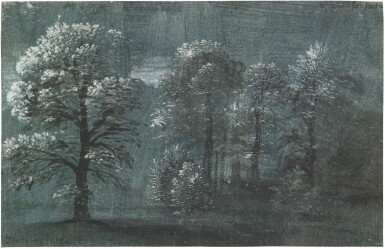A Fine Line: Master Works on Paper from Five Centuries
A Fine Line: Master Works on Paper from Five Centuries

Antwerp School, circa 1530
Trees in a landscape
Auction Closed
July 7, 10:53 AM GMT
Estimate
60,000 - 80,000 GBP
Lot Details
Description
Antwerp School, circa 1530
Trees in a landscape
Point of the brush and dark grey ink, heightened with white, on paper prepared dark blue;
bears attributions, in pen and brown ink, top right corner: v a / Jo: Pate, and bottom left corner: Joachim Patinir, and in pencil, verso: ... Major and Joachim Patinir 31.
112 by 175 mm
by whom sold, Lucerne, Gilhofer & Ranschburg, 28 June 1934, lot 204, reproduced pl. 18 (as Joachim Patenir, 1,700 Swiss Francs, to Dr. Rosenthal);
Dr. L.V. Rosenthal, Bern, and later Montreal, where he changed his name to Randal,
thereafter by descent to the present owners
O. Benesch, 'Meisterzeichnungen des 15. u. 16. Jahrhunderts aus dem südniederländischen Kunstkreis,' Annuaire des Musées Royaux des Beaux-Arts de Belgique, 1, 1938, pp. 34-37, fig. 3;
idem, 'The Name of the Master of the Female Half-Lengths,' Gazette des Beaux-Arts, 23, 1943, pp. 269-82;
idem, 'Die grossen flämischen Maler als Zeichner,' Jahrbuch des kunsthistorischen Sammlung in Wien, 53, 1957, p. 14;
E.H. Turner, review of Bordeaux 1962 exhibition, Vie des Arts, no. 26, 1962, p. 43, reproduced;
C.S. Wood, 'The Errera Sketchbook and the Landscape Drawing on Grounded Paper,' in Herri met de Bles, Studies and Explorations of the World Landscape Tradition, Princeton 1998, pp. 101, 103, 104, 106, 112, fig. 82;
Patinir: Essays and Critical Catalogue, exhib. cat., Madrid, Museo del Prado, 2007, pp. 146–47, reproduced, p. 144;
N. Herman, '"A matter of love": L.V. Randall (1893-1972), Montreal collector and academic visionary', Journal of the History of Collections, February 2021
This poetic early landscape drawing is closely related to some of the sheets in a fascinating and varied small album, known as the Errera Sketchbook, now in the Brussels printroom1, and is very likely also by the same hand as another landscape, now in the Albertina2, with which it was together on the Vienna art market in the 1930s. The Errera Sketchbook, which is generally considered to be the work of at least two, and possibly more, artists working in Antwerp in the second quarter of the 16th century, consists of 84 folios, measuring 135 x 210 mm, which are individually numbered on each side, 1-164 (four sides were left unnumbered). Some of the sheets are prepared, in a manner very similar to what we see here, while others are not, and the technique of the different drawings in the album varies not only as a result of their authorship, but also because of the nature of the support surface on which they are drawn.
Although the general consensus now seems to be that two main artists were responsible for the majority of the drawings in the album, the number, and identity, of the hands involved has been greatly debated. Benesch, who was the first to publish these drawings extensively (see Literature), associated the whole album with the painter known as The Master of the Female Half-Lengths, whom he in turn identified as Hans Vereycke (the name inscribed on two other, rather similar drawings in Louvre, which is that of a Bruges master mentioned by van Mander). Benesch was also the first to link the present drawing and the very similar sheet in the Albertina with the Errera Sketchbook sheets, and indeed these two drawings seem to be the only two Netherlandish coloured-ground landscapes drawings of this period to be found anywhere outside of the Errera Sketchbook.
The use of coloured grounds in drawing is described as early as Cennino Cennini's 1400 treatise, and was very popular from the early renaissance on. The technique provides for great possibilities in modelling, as the mid-tones are already defined by the ground, a base from which the artist can build up both the darks, with pen and ink, or the highlights, with white. A wide range of colours were used, but in German and Netherlandish art, the most common are greens and, as here, blues.
1. Brussels, Musées Royaux des Beaux-Arts, Cabinet des Dessins, inv. no. 4630
2. Vienna, Albertina, inv. no. 26450; see C.S. Wood, op. cit., fig. 86
